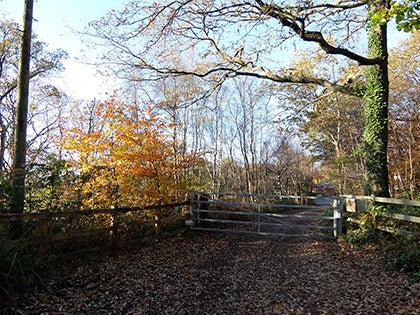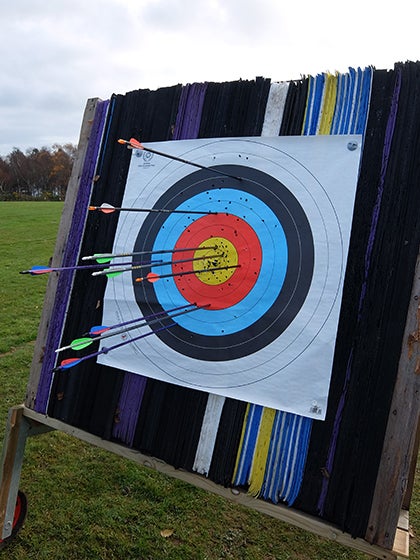Fujifilm XQ1 Review
Fujifilm XQ1 Review
Fujifilm XQ1 Review – The Fujifilm XQ1 is a stylish premium X-series compact which shares the same sensor as the impressive X20. Does it deliver similar performance?
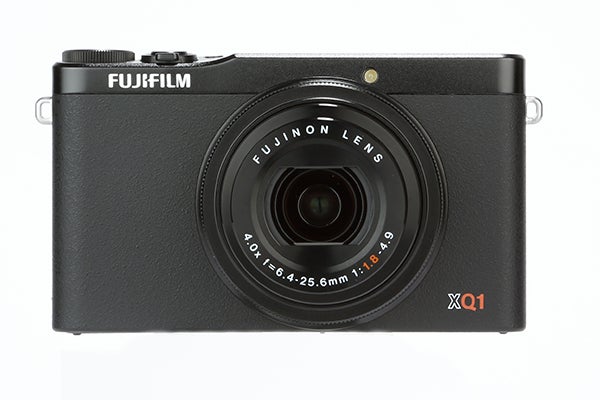
Verdict
Pros
- Design; Build quality; Performance; Features
Cons
- High ISO noise; Image quality
Key Specifications
- Review Price: £349
There’s currently a small but thriving and highly competitive market for pocket-sized advanced compact cameras.
Aimed at enthusiast photographers who want superior image quality and performance in a highly portable format, these miniature marvels combine the photographic prowess of complex advanced compacts with the sleek lines of a fashionable pocket snapshot camera.
The latest example to tempt us is the Fujifilm XQ1. It sports a number of welcome features, such as a large sensor, a strong all-metal body and advanced manual controls, and comes at a lower price than most of its competitors. Can it really be as good as it looks?
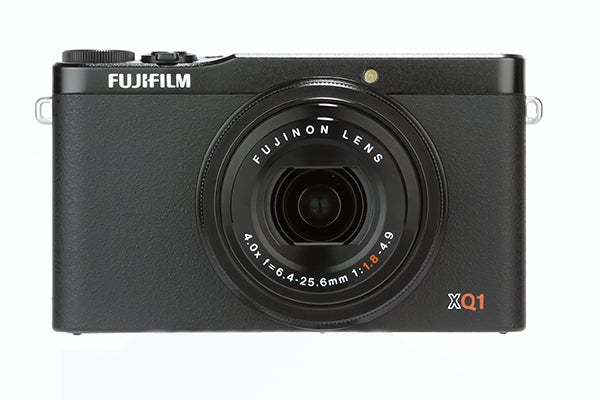
Fujifilm XQ1 Review – Features
Fujifilm’s X-series cameras are built around Fuji’s proprietary X-Trans sensor technology. The X-Trans sensor is intended to mimic some of the characteristics of traditional film, by replacing the usual regular Bayer-pattern colour mask filter with a new filter in which the colour filters are laid out in a more random pattern. This eliminates the Moire patterns associated with the regular Bayer filter, and thus also eliminates the need for an anti-aliasing filter.
In theory this means that X-Trans equipped cameras should be inherently capable of producing sharper pictures than their Bayer-mask rivals. The XQ1 has an X-Trans CMOS II sensor, and quite a large one compared to most other compact cameras.
Most advanced compacts have 1/1.7-in sensors, measuring approximately 7.6 x 5.7 mm, a surface area of 43.3 square millimetres. The XQ1 has a 2/3-in sensor, which measures 8.8 x 6.6 mm, giving it a surface area of 58.1 square millimetres, roughly 34% larger.
With an effective resolution of 12.0 megapixels this should – again in theory – give the XQ1 an advantage in low light performance, dynamic rage and high-ISO image noise.
The X-Trans sensor also incorporates special phase detection sensors, giving the XQ1 Fuji’s unique hybrid phase/contrast detection autofocus system, previously seen on other X-series cameras. It promises faster and more reliable focusing, especially in low light.
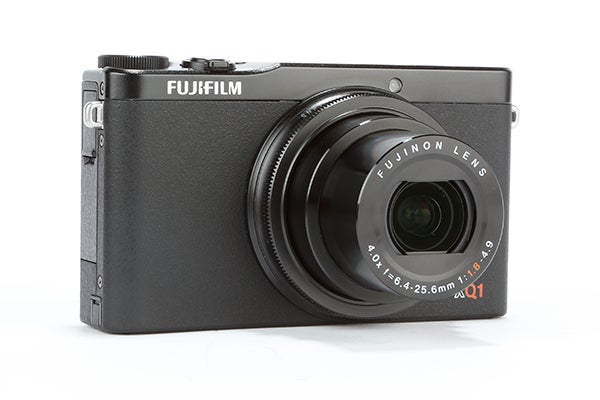
Exposure modes
The XQ1 has a typical range of exposure modes, selected via the dial on the top panel. As well as the usual program auto, aperture and shutter priority, and full manual exposure, it offers auto, advanced scene recognition auto, a fairly typical range of scene modes and an interesting selection of digital filters, as well as a panorama stitching mode.
While the selection may not be too inspiring the degree of control is above average, with aperture, shutter speed and ISO all adjustable in 1/3EV increments.
There are several other features that will be of interest to experienced photographers, such as in-camera Raw conversion, focus-peaking, and of course Fuji’s film-simulation modes, in which the camera seeks to duplicate the tone of Velvia, Provia
Like most other advanced compacts the XQ1 has a high performance lens, with 4x optical zoom, equivalent to 25-100mm, a maximum aperture of f/1.8 – f/4.9 and a minimum aperture of f/11. It’s a powered zoom with an automatic lens cover, controlled by a rotary bezel around the shutter button.
The monitor is very good, but like the other features it is fairly run-of-the-mill by current advanced compact standards. It has a 7.5cm (3.0in) TFT screen with 920k dot resolution, a very good wide viewing angle and an effective anti-glare coating.
Wi-Fi connectivity is a must-have feature these days, so naturally the XQ1 can connect to your home network for wireless downloading, but unlike some recent cameras it lacks the latest smartphone connectivity and app controls.
Fujifilm XQ1 Review – Design
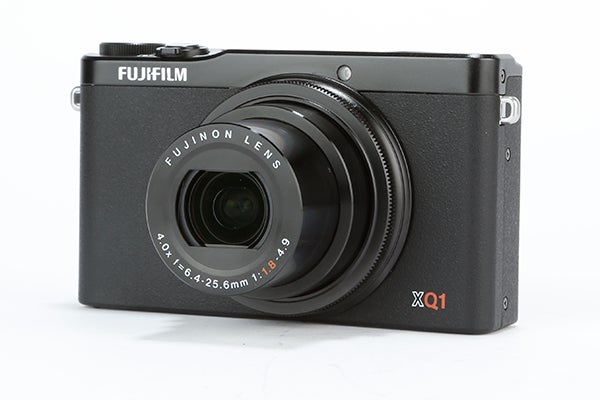
When talking about the design of the XQ1, it’s impossible to avoid drawing comparisons with one of its major rivals, the Canon PowerShot S120. The two cameras are so similar in appearance that at a quick glance it’s hard to tell them apart.
They are within a fraction of a millimetre of being the same size and within a few grams of being the same weight. Both have part-textured bodies with smooth top panels, the control layouts are virtually identical, with control rings around the lens, and both have manually-activated pop-up flashes.
The only major design difference is that the Canon has a touch-screen interface, while the Fuji XQ1 doesn’t. It’s hard to say which of the two is the better design, but there’s no denying that the Fuji is a very handsome little camera. Unlike its Canon rival it is available in black or silver.
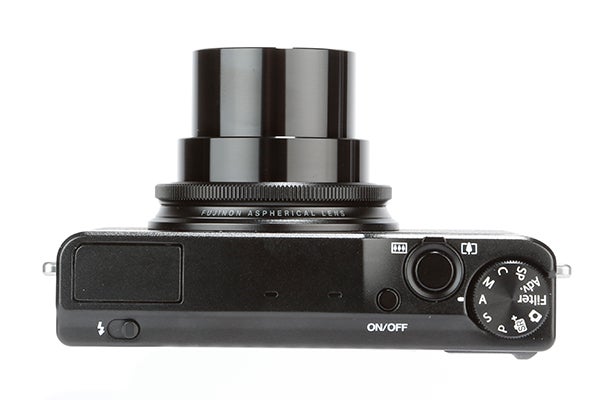
Simple structure
The body design is very simple with straight edges, square corners and flat panels, and the slight step in the top panel is obviously intended to echo the retro rangefinder design of its larger X-series siblings. The rectilinear body is fairly comfortable to hold, and the slightly rough texture of the finish along with the small rear thumbrest does provide a secure grip, but a small front handgrip would have been a welcome addition.
The control layout is fairly conventional, with a main exposure mode dial on the top panel, and a D-pad with a rotary bezel and four buttons on the rear. The only unusual control is a ring around the lens for adjusting aperture or shutter speed, but even this is not unique. The comprehensive seven-page menu is rather plain, but it is at least easy to read and sensibly laid out, and is quick and easy to navigate.
The XQ1 has an all-metal body which feels very strong and durable. The overall build quality is excellent, with nice tight panel seams and solidly mounted controls. The battery hatch has a strong metal hinge, although the plastic cover over the USB/HDMI socket is a bit flimsy. The tripod bush is metal as you’d expect, but it is positioned off the optical centre line.
Fujifilm XQ1 Review – Performance
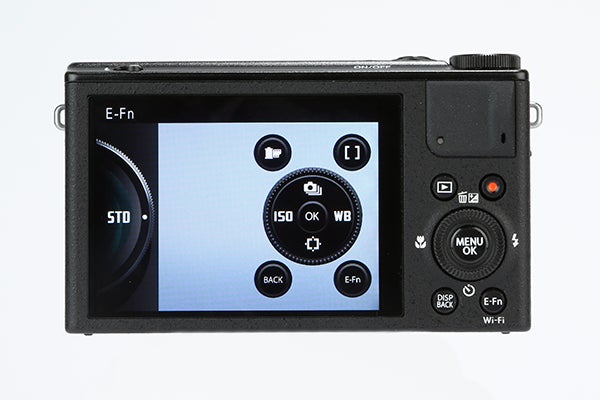
The XQ1 is designed to meet the needs of demanding photographers, and that includes overall performance. It certainly doesn’t hang about; it can start up and take a picture in a little over one and a half seconds, which is refreshingly fast, and shuts down again just as quickly.
Shooting single-shot in JPEG fine mode it has a consistent shot-to-shot time of approximately 0.8 seconds, and in Raw + JPEG mode of 0.9 seconds, both of which also nice and quick. The XQ1 has several continuous shooting modes, ranging from low speed (3fps for 200 frames) to Super High, which can shoot nine frames at 12fps, but to get the best out of it you’ll need to use the fastest class 10 SDHC cards (10MB/s).
Using slower cards affects not only the speed but also the maximum number of frames.

AF Performance
The hybrid phase/contrast detection AF system is certainly fast, focusing almost instantly in good light, but unfortunately it’s not as reliable as we’d hoped.
Given that the X-A1 and X-E2 were also a little disappointing in this department, perhaps some more work is needed before the hybrid AF technology delivers on its potential.
As it stands the XQ1 frequently takes two or three attempts to focus on some subjects, especially in low light, but at least it fails quickly rather than hunting around.
The XQ1 is powered by a 1010mAh li-ion battery, which is about average for a camera of this size. Fuji makes no particular claims for the number of shots it’s supposed to deliver on a full charge, but we were a little disappointed when it ran out after just 170 shots and about 20 minutes of video, shot over the course of a week.
As we’ve noted before, li-ion batteries do take a few charge cycles to reach full capacity, so it may go as high as 200 shots, but even so this is still something of a limitation.
Fujifilm XQ1 Review – Image Quality
Fujifilm has often been at the forefront of sensor development, pushing the limits of low-light sensing and high-ISO noise reduction.
The X-Trans sensor technology promises sharper, more detailed images, and has been widely praised in the APS-C format X-series cameras, so naturally we had high hopes for it in this smaller 2/3-in format. Sadly we were left feeling a bit disappointed.
Colour and White Balance
Colour reproduction has always been a Fujifilm strong point, as you’d expect from one of the world’s leading film manufacturers. In this respect at least the XQ1 doesn’t disappoint. Colours are bright and natural, with the standard film mode producing gorgeous skin tones, natural colour saturation and a nice even tone.
The Velvia simulation produces more vibrant colour saturation, with rich reds and greens. White balance is also generally very good, producing accurate colour reproduction under a wide range of different lighting conditions.
Exposure
Exposure metering is also generally accurate, managing to avoid under or over-exposure even under difficult lighting conditions.
The larger sensor does produce good dynamic range, managing to avoid highlight clipping even in high-contrast situations. Even with shaded foreground subjects there was always detail in the sky.
Resolution
The main selling point of the X-Trans sensor is that the new colour filter mask eliminates the need for an anti-aliasing filter, which in a camera with a conventional sensor slightly blurs the image to avoid unpleasant Moire patterns when photographing fine detail.
In theory therefore the XQ1 should produce sharper, more detailed images than its 12-megapixel rivals. Unfortunately having examined comparison shots side-by-side it’s hard to see any advantage.
Maybe the lens just isn’t as sharp, maybe the JPEG encoding is poorly processed, or maybe the new technology just doesn’t work as well on a smaller sensor.
Either way the XQ1 just doesn’t produce the kind of ultra-sharp detail we’d hoped.
Image Noise
The biggest disappointment is the XQ1’s high-ISO noise control, traditionally something of a Fujifilm strong point. We’ve tested previous X-series cameras, both with X-Trans sensors and with conventional CMOS, and found the results to be outstanding.
However the XQ1 starts having noise problems from about 800 ISO upwards, and by 6400 ISO the images are pretty much unusable. The 12,800 ISO maximum setting is particularly poor
Lens performance
Some of the blame for the XQ1’s disappointing image quality must be pointed at the lens. It simply isn’t very sharp, but at least it’s fairly consistent about it, with no particular corner blurring or distortion.
It also manages to avoid chromatic aberration, although unfortunately the sensor does suffer from highlight charge leakage, where charge leaks from over-exposed highlight areas into darker adjacent areas, producing a blue fringe.
This is something of a perennial problem for Fujifilm compacts; hopefully they’ll come up with a solution someday.
Fujifilm XQ1 Review – Verdict

Trying to sum up our feelings about the Fujifilm XQ1 isn’t easy. It has a lot to recommend it. It has a good range of features, a simple and easy-to-use control interface and decent overall performance; it looks good and it’s certainly well made.
However it’s the final image quality that really counts, and it’s hard to avoid a sense of disappointment that the results just aren’t as good as they might be.
Fujifilm has a long history of experimentation and innovation in sensor design; the X-Trans sensor technology certainly looks promising on paper and may work well in larger formats, but in the XQ1 the promised quality just isn’t delivered.
The clever filter mask may eliminate Moire patterns, but it doesn’t avoid jagged diagonals, and the high-ISO noise is surprisingly bad for a camera with a larger-than-average sensor. Simply put, while it has some good ideas, you can get better image quality elsewhere for less money.
Fujifilm XQ1 Review – Sample Image Gallery
These are just a small selection of images captured with the Fujifilm XQ1. For a wider range, head on over to the Fujifilm XQ1 review sample image gallery.
First Look
As well as announcing the X-E2, Fujifilm has also launched the XQ1, a premium compact camera that shares the same 2/3in X-Trans CMOS II sensor and EXR Processor II as the X20. Featuring an ISO range from 100 to 12,800, the sensor does away with the need for an anti-aliasing filter in favour of greater detail from its 12MP of resolution.
Rather than follow the collapsible manual zoom lens we saw in Fujifilm’s other most recent premium compact, the 4x optical zoom features a more popular electronic mechanism. With a coverage from 25-100mm, it offers a fast maximum aperture of f/1.8 at the wide end, while there’s a control ring round the parameter of the lens that can be programmed to adjust a range of settings. It’s also possible to directly access preferred functions via the expansion function button on the rear of the camera.
Also included is a Lens Modulation Optimiser, which corrects optical defects and diffractions that result from using narrow apertures and therefore provides edge-to-edge image clarity. The lens comes with 3-stop optical image stabilisation for shooting in low light
The XQ1 is exceptionally speedy, boasting AF of 0.06 seconds, a shooting interval of 0.3 seconds and a microscopic shutter lag of 0.015 seconds. It incorporates Fujifilm’s Super Intelligent flash technology, which automatically assesses a scene and adjusts the flash output to compensate.
There’s a 3in screen at the rear with a 920k-dot LCD display with
anti-reflective glass, while as you’d expect from Fujifilm, there’s also a host of Film Simulation modes as well as Advanced Filter options. Multiple Exposure mode also provides the option of laying multiple images over a single frame. You can also use the LCD screen for Focus Peak Highlight, which highlights the outline of a main subject when high contrast might make it difficult to see.
While the XQ1 shoots Raw, it also has the capacity to convert to Jpeg in-camera, meaning it’s easy to share an image instantly if you think you nailed it first time. To do this there’s built-in Wi-fi, with instant sharing possible via the Fujifilm Camera Application app.
Full HD movies shooting at 60fps is possible on the XQ1, and you can apply the Film Simulation modes to video footage to give movies a distinctive look.
The XQ1 is priced at £349, available in black or silver, and should be on sale from the beginning of November.
Trusted Score
Score in detail
-
Value 8
-
Design 9
-
Features 9
-
Image Quality 8
-
Performance 8

